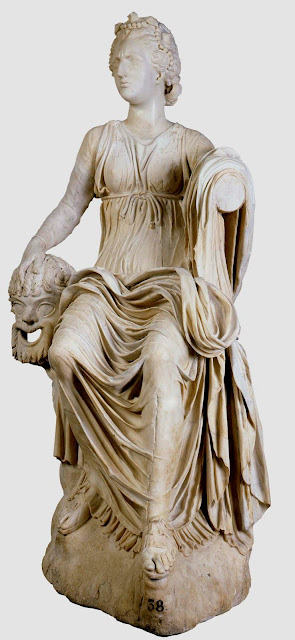 |
| Calliope, Muse of Epic Poetry marble AD 130-150 and 18th century Prado |
When these marble muses were owned by the Borgia Pope Alexander VI in the late 15th century there were nine of them, the canonical number. When they ornamented the Roman palace of Queen Christina of Sweden in the 17th century, there were only eight. Melpomene, Muse of Tragedy had gone missing.
The bodies were carved in Rome between AD 130 and 150. These were excavated in or near Rome not long before the Borgias obtained them. Neither Pope nor Queen ever saw the heads or arms on these statues as we see them now. These additions, improvements, and substitutions were carried out late in the 18th century by a neoclassical sculptor named Valeriano Salvatierra. The statues were then in the hands of descendants of the noble Romans who had inherited them from Christina.
The Prado displays the Muses as the hybrid productions they are. In fact, most of the Roman statuary in the Prado did not reach the museum before it had passed through the bold and ruthless Italian restoration factories of the 16th and 17th and 18th centuries.
 |
| Clio, Muse of History marble AD 130-150 and 18th century Prado |
 |
| Euterpe, Muse of Music & Song marble AD 130-150 and 18th century Prado |
 |
| Erato, Muse of Lyric Poetry marble AD 130-150 and 18th century Prado |
 |
| Polyhymnia, Muse of Hymns marble AD 130-150 and 18th century Prado |
 |
| Terpisichore, Muse of Dance marble AD 130-150 and 18th century Prado |
 |
| Thalia, Muse of Comedy marble AD 130-150 and 18th century Prado |
 |
| Urania, Muse of Astronomy marble AD 130-150 and 18th century Prado |
I am grateful for the beautiful reproductions made available by Museo del Prado.